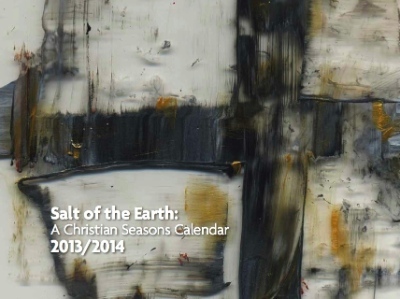 Eugene Peterson, Anne Lamott, Walter Brueggemann, Tony Campolo and many other notables around the Christian world are admirers of the Christian Seasons Calendar which is produced by Ed Searcy and his church in Vancouver. Peterson, for example, says: “Every day is holy, a gift of time in which we enter into the great rhythms of God’s creation and salvation. This calendar brings fresh awareness to the essential sacredness of what is so easily profaned by hurry or sloth.”
Eugene Peterson, Anne Lamott, Walter Brueggemann, Tony Campolo and many other notables around the Christian world are admirers of the Christian Seasons Calendar which is produced by Ed Searcy and his church in Vancouver. Peterson, for example, says: “Every day is holy, a gift of time in which we enter into the great rhythms of God’s creation and salvation. This calendar brings fresh awareness to the essential sacredness of what is so easily profaned by hurry or sloth.”
From the moment of birth we learn to tell time. The regular patterns of sleeping and waking, the rhythms of meals and bedtime rituals are quickly learned by the youngest in our midst. Our children soon develop a sense of past and of future. The story that is told about our past and our future becomes the underlying narrative of our identity. It tells us and others who we are. It guides our way of being and doing in the world.
As Christians, the story of the Way of Christ is our calendar, our identity, our past and our future. The gospel gift that is stewarded and passed on by one generation to another is the inheritance of a past and a future shaped by the story of what God in Jesus is up to in the world.
Telling time in Christian community is profoundly intergenerational and always problematic. Take the basic season of Jewish and Christian life – the week. “Six days you shall labour and do all your work. But the seventh day is a Sabbath to the Lord your God; you shall not do any work” (Exodus 20:9-10).
In the aftermath of a Christianized culture that gave legal protection to the Lord’s Day we are now submerged in a culture of endless shopping, working, chores, to-do lists, homework and schedules that seem to never end. The pressures to abandon the peculiar biblical way of telling time are huge.
A recent Christmas found the 25th of December falling on a Sunday. In the face of expectations (both within and without the church) that Christmas Day is a day to be with family, some congregations made the decision to cancel sabbath worship.
A Buddhist friend wondered aloud: “So have I got this right – Christians are choosing not to worship on a Sunday because it is the day set aside to celebrate the birth of Christ?” Sometimes it takes an outsider to see how the way we keep time reveals our highest loyalties and allegiances.
Telling time that is grounded in Sabbath practice teaches our children and our elders that we are not saved by our work or by our productivity. It locates our past and our future in God’s rest. A Sabbath people are not identified as consumers or as units of productivity, as failures or as heroes. Such a people will learn that it’s life begins and ends in God’s rest.
Our first response to the Sabbath commandment is to argue “But it is so difficult to keep the Sabbath in our culture.” Is this the reason that the church we inhabit has largely acquiesced to a never-ending production schedule and shopping calendar?
It is something of a surprise to discover that the radical Christian community of tomorrow is discovering its capacity to live an alternate life of modest needs and of sacrificial ways by learning to keep the sabbath with its children today.
As children grow, the regular pattern of the week extends into the rhythm of the year. Great celebrations such as birthdays and Christmas seem to take forever to arrive. Over time, the marking of the seasons provides a deep foundational identity that is carried forward by the memory that each festival holds.
The way we tell what time it is tells us whose people we are. The recovery of telling time with the seasons of the Christian Year is a political activity. It intends to form an alternate ‘polis’ – a people – whose time is ordered by the coming of Jesus, the calling of a salty people and the promise of God to redeem the creation.
This is never more evident than in the recovery of Advent as a season of waiting for the 12 day festival of Christmas. Here the church lives a counter-story to the enticements and temptations of a shopping spree Christmas that has long forgotten Mary’s song: “He has filled the hungry with good things, and sent the rich away empty.” (Luke 2:53)
The alternate culture that is the life of Christian households and congregations is patterned in our hearts, minds and bodies as we turn the pages of seasons that move from Advent to Christmas, from Epiphany to Lent, from Holy Week to the 50 days of Easter, then to Pentecost and the long season of life lived inspired by the Holy Spirit to daring discipleship.
At University Hill Congregation we imagined that having an alternate Christian Seasons Calendar on our walls would help us to live more fully inside the time of God’s kingdom come. To our surprise this small venture spread by word of mouth to others who find it to be a compelling witness. Those first photocopied calendars are now thousands of printed calendars annually shipped across North America and around the world.
It turns out that obeying the Sabbath commandment, and doing so within the framework of the Christian year, is a crucial calling and challenge for Christian households and congregations. It is a crucial calling because telling time in ways that teach us who and whose we are affords the promise of passing the good tidings from one generation to another. It is a crucial challenge because the cultural world we inhabit uses time to tell us a different story about ourselves, our neighbours, our enemies and our God.
Ed Searcy is pastor of University Hill Congregation on the UBC campus. He says a “crazy idea” in the week before Advent 1999 led to the calendar. The children’s minister, Janice Love, “taught us that the Christian Year is a powerful resource for forming Christian identity in children and in adults. At the time I was immersed in studying teachers like Walter Brueggemann and Stanley Hauerwas who were emphasizing the importance of living within the narrative of the Christian story . . . One evening I was thinking about Janice’s plans for a Christian New year’s party and suddenly wondered why Christians were not using calendars that began with Advent instead of with January. As I thought about it, I imagined that such calendars would not turn in evenly measured months but with the turn of each arriving Christian season. It was a highly impractical, whimsical, even crazy idea. But when I shared it with Janice she immediately went to work on her computer and created a prototype of a Christian Seasons calendar.”
For more on how the calendar came into being, click here.
Initially they used art from within the congregation, but soon ran out of images. Now they receive submissions from Christian artists across North America and beyond.
Among the main features of the calendar:
- Contemporary art from 10 artists depicting the gospel story
- Scripture readings for Sundays and special days from the common lectionary
- Descriptions of the Christian seasons and suggestions for ways to celebrate them
- Liturgical colours for each season




